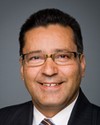Mr. Chair and distinguished members of this committee, on behalf of Human Resources and Skills Development Canada, I would like to express my appreciation once again for this opportunity to contribute to your study on foreign credential recognition.
I am Jean-François LaRue, director general of the labour market integration directorate and with me is Mr. Jonathan Wells, director of operations.
Foreign credential recognition is a multi-dimensional issue requiring actions from a number of stakeholders and key federal departments. Over the years HRSDC has made significant progress in this area because of the active involvement of Health Canada and Citizenship and Immigration Canada. As you know, each department has developed a specific expertise that is fundamental to strengthening foreign credential recognition systems in Canada.
Mr. Chair, the witnesses that have testified before the committee represent a broad range of occupations. Despite the economic slowdown, many of them have indicated that they are either currently facing a shortage of skilled workers, or will be in the very near future due to Canada's aging society. The shortage of workers is and will continue to be felt by employers across many sectors.
As a result, our country will rely more and more on internationally trained individuals and Canadians trained abroad to fill these gaps. When I refer to these two groups of individuals, I often refer to internationally trained workers. These individuals have the skills, knowledge, and capacity to contribute to the success of businesses and the social fabric of Canada. The competition for top talent is also intensifying across countries, and those that can best meet their needs and interests will succeed in tomorrow's economy.
You will have noticed over the last few weeks that occupations are at very different stages of improving their FCR processes. Some of them are making first steps, such as conducting diagnostic and environmental scans, while others are more advanced in this work and are creating national assessment processes and developing online tools.
I mention this to reinforce the fact that overcoming systemic foreign trade recognition, or FCR, barriers is an ongoing, evergreen task that requires the sustained efforts of all players and cannot happen overnight. It requires the willingness and open mind of all stakeholders to consider a slightly different, or even a completely new way of doing business.
The Pan-Canadian Framework for the Assessment and Recognition of Foreign Qualifications has been instrumental in fostering these ongoing partnerships with stakeholders. Over the last two years, focused work on targeted priority occupations has resulted in much progress, including building FCR capacity among regulatory bodies, facilitating national coordination, and helping individuals with pre-arrival information.
For this reason, it is important that we continue fostering these relationships and encouraging stakeholders to streamline their FCR processes. We are exploring with provincial and territorial governments ways to extend the framework beyond 2012, to maintain the current momentum and to adequately respond to future labour market needs.
Even though much progress has been made by stakeholders across many occupations, barriers still exist. Witnesses highlighted some of the areas where they think additional support from governments would make a significant difference. These messages have been consistent with those we heard in national consultations with occupations targeted under the framework. I would now like to take a few minutes to touch on some of them.
You heard about the critical importance that skilled trades play to our economy and the looming skills shortages we're facing. As you know, apprenticeship and trade certification is a provincial and territorial responsibility, with multiple approaches. This means 13 different systems, over 300 regulated trades, and a complex mix of compulsory and non-compulsory trades. In the trade occupations, the Red Seal endorsement, currently available in 52 trades, represents a standard of excellence, as it ensures mobility and the recognition of the qualifications of certified tradespersons. The Red Seal is managed by the Canadian Council of Directors of Apprenticeship, CCDA, which brings together the federal, provincial, and territorial governments to develop national standards and examinations for the skilled trades, in collaboration with industry. HRSDC is currently working with the CCDA to look at how best to apply the framework to the skilled trade occupations.
In addition, over the past two years the CCDA has been exploring an expanded range of competency-based methods for assessing individuals, beyond the current multiple-choice exam, through the multiple assessment pathways pilot project. This expanded range of assessment tools and methodologies could provide an effective way to assess a broader range of candidates, including internationally trained individuals, for whom a written assessment may create a barrier to certification unrelated to their level of competency.
Furthermore, the Saskatchewan Apprenticeship and Trade Certification Commission, with funding from the FCR program, recently commissioned a study to better understand how the credentials and trade experience of internationally trained individuals in the Red Seal trades are assessed and recognized across the country. This study resulted in a number of recommendations that will be considered by the CCDA to improve the FCR and work experience for the skilled trades.
While many witnesses discussed the successful outcomes of bridging programs, they've also confirmed that their sustainability is very challenging. As you know, these programs bring together key stakeholders to assess skills and competencies and to deliver short, intense training to fill the gaps. Most importantly, they limit the need for internationally trained individuals to redo education and training completed abroad, which in turn speeds up their integration into the Canadian labour market.
HRSDC has already made several investments in bridging programs, the most recent being announced just last Wednesday by Minister Finley. The FCR program is funding the Canadian Institute of Chartered Accountants project, “Learning Assessment and Bridging Programs for Internationally Trained Accountants”. Not only is this project going to create an online tool to assess foreign education and work experience, it will also create customized bridging programs to help foreign-trained accountants complete any additional courses and exams they may need to become accredited in Canada. This will help internationally trained accountants find jobs faster in their field.
The development of mutual recognition agreements, or MRAs, is another area that witnesses highlighted as being important for government to continue to support. These agreements can help speed up the integration of internationally trained individuals, even before they leave their home country, as they prevent additional and duplicative FCR assessments upon arrival in Canada.
HRSDC supports stakeholders in this area, as per the recently announced project with the Canadian Foundation for Economic Education. This organization will hold a workshop with over 40 Canadian regulators and professional associations that will focus on the development and management of MRAs with other countries. This workshop will demonstrate the success that stakeholders have had with these agreements, identify best practices, and hopefully encourage other occupations to pursue the development of additional MRAs.
Witnesses have also described to you that many internationally trained individuals have difficulty paying for the tuition and other training costs associated with the FCR process. Witnesses have called upon government to find ways to support these individuals, as these costs can be prohibitively expensive for some, especially for an internationally trained individual who lacks the credit history to secure the necessary loans to cover tuition and other training costs.
I would like to take a moment to remind the committee that budget 2011 announced a complementary financial assistance pilot project. This pilot will test ways to help internationally trained individuals to cover costs associated with the FCR process, and will determine the extent to which governments can play a role in this area.
As we move forward to address these challenges, we will continue to carefully consider where to invest next. Ensuring that we have better data to support evaluation and reporting needs will be one of our focuses in the months to come. Witnesses have described their difficulties in collecting and tracking data to measure progress as these individuals go through the FCR process. This is in part due to the large number of players that are involved in the process and the uneven practices in collecting data. One good example of best practice is the work of one of the witnesses you received, the Manitoba fairness commissioner, Ms. Ximena Munoz.
With those considerations in mind, we are working with provincial and territorial governments to improve our ability to measure the framework's performance. This will enable us to broaden our knowledge and understanding of the challenges faced by internationally trained individuals and enhance our ability to invest in the areas that will make the biggest impact.
I have highlighted only some of the many areas where the FCR program has helped these stakeholders improve their FCR process. I have also only touched on some of the areas where continued investment from government can make a significant difference to help internationally trained individuals to overcome FCR barriers.
To conclude, and this is really important, I would like to re-emphasize that in recent years the framework has been instrumental in providing stakeholders with opportunities they may not have had otherwise. As many witnesses have clearly indicated, we do have the right approach. Given these achievements and remaining challenges, the federal government must continue to work with key stakeholders to maintain momentum. I look forward to the recommendations of the committee in this regard.
Thank you, Mr. Chair.





